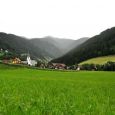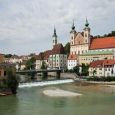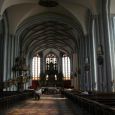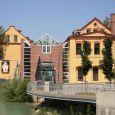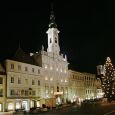Steyr
Advertisement
By Train
Steyr is on the path Rudolf.There are regular transit traffic to Linz (about St. Valentine with connections to the Western Railway ) and after Kleinreifling.The section of St. Valentine to Steyr was opened in 1868.The current design of the superstructure of the main railway station, railway facilities ( garage, regional bus station ) and covered the central platform was established in November 1998.The 1889, and 1982 set narrow Steyrtalbahn resulted from the western edge of the city railway station Steyr local train to Green Castle, Molly and Klaus with a branch line to Sierning and Bad Hall, and in the other direction to the nearby Garsten with connection to Rudolf train.The section of Steyr-local train to Green Castle has been preserved as a museum railway.Trains during the summer months and during the Advent season each.Son of Sam and holidays.
By Bus
Post buses operate among other things to Linz, Kirchdorf an der Krems, Amstetten and catfish.For public transportation within the city is the city bus Steyr responsible.From Christmas to New Year's Eve runs an annual vintage bus service between the Styrian town square and the parsonage Christmas.Depending on the day also the cadastral Gleink (be Martin's Market ) and the neighboring community Garsten (Garsten Advent) is approached.
By Road
By the highway B309 ( Steyr Street ) the city has since autumn 2010 to the A1 connected.Previously owned Steyr no quality road access.To the running through the city roads which belong alpine road B122 to Sattledt and the iron road (B115) on Hieflau, iron ore and the Präbichl pass by Leoben and Traboch.
St. Michael's Church
is a Roman Catholic Church in Steyr.The former Jesuit church of St. Michael's parish church and by their highly visible well location at the mouth of the River Enns Steyr mark on the city of Steyr.The victory over the invading Turks from the east brought the new architectural impulses - the Baroque style became an expression of the major renovation of cultural and religious life. The Catholic restoration was another indicator of the effusive phase of renovation in the Steyr church landscape.In the period 1635 to 1681 originated in Steyr, which had been the center of the evangelical faith community, three Baroque monastery buildings the Church of St. Michael, the Dominican Church and the Church of Colestinerinnen.The church stands on a huge increase over the beachhead and dominates the town of Steyr village. The three-story, twin-towered facade has a monumental entrance, dated 1677, with the inscription HIC DEUM ADORA ( Lat. here worship God), it stands in a niche, a statue of the Virgin Mary with baby Jesus, flanked by statues of the apostles Peter and Paul. At the top of the crest of the prince of the portal Eggenberg is incorporated.
Museum work Steyr
is located in a revitalized style factory building from the mid-19th Century on the Steyr River.It was in 1987 as part of the Upper Austrian regional exhibition "work / human / machine.The way in which industrial society was founded." Subsequently it was transferred to a museum in continuous operation and has established itself with extensive exhibitions, projects and events on socially relevant topics as an internationally recognized cultural center.In 2002, the entire exhibition area was destroyed by a flood of Steyr, but subsequently rebuilt.The current exhibition "Working and living in a globalizing world" tries to the visitors of the globalization process the world of work not only to grasp intellectually but to do with all your senses come alive.The focus of interest are the mechanisms of the ever expanding international integration of production and their impact on work, life and society.
Steyrtal Railway Museum
is Austria’s oldest narrow-gauge railway with a gauge of 760 mm.It has been on the tracks for more than 100 years and thanks to the loving care of the OGEG the train is still travelling the 17 km long route between Steyr and Grünburg. In the Advent season the historical museum railway travels along the Steyr river through romantic meadowland to the Steinbacher Advent and back to the Christmas town.Museum is operating on Saturdays and Sundays from June to September and weekends during Advent, next will be on order at any time out special features.All other tracks were removed. On the route Grünburg-Klaus a bike lane was created (part of Steyrtalradwegs ). At the branch line Perger Bad Hall remember above all the bridge abutments of the Steyr.The Austrian Society for Railway History (ÖGEG) took over the local railway track Steyr-green castle since 1985 and operates as a museum railway with steam trains.
The Old Town Theatre
is a former Baroque monastery 1796 it was converted into a theater and on 16 May with the opera of Gypsy Christian Gottlob Neefe inaugurated.The construction of a larger theater in the industrial hall in 1958 (New City Theater, Popular Road 5) resulted in the closure.After renovation work, which was published by the entrance to the promenade, among other things, the house is re-recorded since autumn 1980.There are 233 seats and 30 standing places on the gallery.The new theater was opened in 1898 attached to the 1957/1958 industrial hall. In the hall was the popular cinema since 1924. In the bulk construction procedures established house received a highly advanced for its time on stage technical apparatus, then the turntable over 11 meters in diameter.The opening took place on 27 September 1958 with Giacomo Puccini's La Boheme.The house offers a total of 588 people.
Lamberg Castle
is a castle in Steyr in Upper Austria.It is situated on a high terrace above the confluence of the Steyr in the Enns.The castle was built from the Styraburg, the namesake for the city of Steyr, and the province of Styria was. Since the building from 1666 to 1938 in the family Lamberg was whose name was on the lock.at the beginning of the 10th Century built and 985 first mentioned. It belonged to the Counts Traungauer (Otakars).Otakar II in 1078 is first mentioned 1079 Styraburg is his residence. 1192 the castle was due to George Handfeste the Babenbergs later to the Habsburgs.1666 the castle came into possession of the rule, including Count Lamberg.In 1727 the plant was destroyed by fire and by Johann Michael Prunner rebuilt.Around the year 1750, the castle belongs to the most basic rule of government in Upper Austria.The castle was built during the French Wars seriously damaged in 1800, 1805 and 1809.The Roman tower got its present distinctive crenellated platform surrounded by the great fire of 1824.
Engelsegg Castle
was built around 1500 castle in Steyr, 9 Redtenbachergasse No. Until 1642 the estate was Teufelsegg.The outer walls of the building are laid in a horseshoe shape with fake blocks and arched friezes decorated.The former castle wall with round towers and loopholes is still partially preserved, for example Redtenbachergasse out.Builder is probably the wealthy cloth merchant Hans Fuchs Berger, who was in 1525 and -26 also Steyr mayor.Josef night market night market Stone (mayor from 1642 to -45) bought the castle in 1641 and built it in the Renaissance to style, 1642, he applied to the Emperor Ferdinand III the renaming.The old name may come from neighboring Teufelsegg Teufelsbach that far into the Steyr flows.One of the owners in the 19 Century was the industrialist Josef Werndl, who by 35,000 guilders earned.Today it belongs to the town of Steyr.
March - June
August - November


